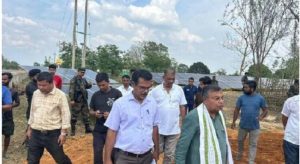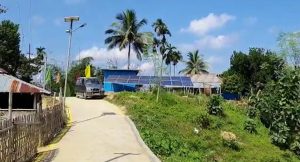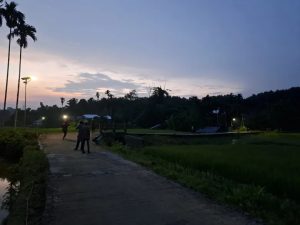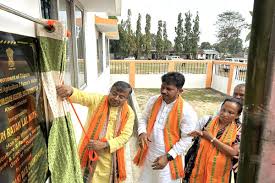Tripura’s Renewable Energy Push: Rangachara to Become a Model Solar Village
Nestled in the South Tripura district, Rangachara is making headlines as it gears up to become the first fully solar-powered village in the state. This groundbreaking initiative is led by the Tripura Renewable Energy Development Agency (TREDA) in collaboration with the Ministry of New and Renewable Energy (MNRE), aiming to deliver clean, uninterrupted electricity to over 600 families through sustainable and decentralized solar energy solutions.


The Vision for a Solar Village
The remote village of Rangachara has long grappled with inconsistent electricity and limited access to infrastructure. Recognizing the need for reliable and sustainable power, the Tripura government has launched an ambitious solar village project under the central Solar Village Scheme. State Power Minister Ratan Lal Nath recently visited the village, reaffirming the government’s commitment to a greener and more energy-secure future for rural Tripura.
According to Minister Nath, this project is more than just an energy transition — it is a complete transformation of how energy is produced, stored, and consumed at the grassroots level. TREDA has been tasked with completing the installation within a specific timeline, ensuring that all 600 households in Rangachara benefit from solar-generated electricity.
What the Project Includes
The solar village initiative encompasses a wide range of sustainable infrastructure developments. Each household will be equipped with rooftop solar panels, battery storage units, and energy-efficient appliances. This approach will allow villagers to harness sunlight during the day and use stored energy at night, significantly reducing their dependence on conventional grid electricity.
Additionally, the project will expand to include solar-powered streetlights and renewable energy support for public facilities such as schools, health centers, and community halls. This initiative is not just residential—it’s community-wide. For the local agrarian economy, solar-powered water pumps and borewells will boost agricultural productivity while reducing environmental impact.
In the event of inadequate solar generation due to weather or technical issues, the village will still have access to backup grid power supplied by the Tripura State Electricity Corporation Limited (TSECL). This hybrid energy model ensures no household is left in the dark.


Government Schemes and Community Participation
The project aligns closely with the national push for clean energy under schemes like the Pradhan Mantri Surya Ghar Muft Bijli Yojana, which advocates free electricity through rooftop solar installations across the country. The state government has been promoting the adoption of this scheme to bring solar power to even the most remote areas.
Minister Nath highlighted the proactive role of TREDA, not just in implementation but in community awareness. Through workshops and community meetings, local residents have learned about the benefits of renewable energy and how to maintain the systems. This empowerment model encourages a sense of ownership and long-term sustainability.
Impact on Rural Development and Sustainability
This move is expected to have far-reaching implications for rural development in Tripura. Consistent electricity means improved educational opportunities, better healthcare services, and enhanced security through well-lit streets. Farmers will benefit from more efficient irrigation systems, reducing water waste and increasing crop yield.
Women, who often bear the brunt of inadequate electricity in rural households, will now have more reliable lighting and access to energy-efficient appliances, potentially improving health, hygiene, and livelihood opportunities.
From an environmental standpoint, the project will significantly reduce carbon emissions and promote a culture of energy responsibility. By decreasing dependency on fossil fuels, the village is contributing to India’s broader goal of achieving net-zero emissions by 2070.
A Blueprint for Other Villages
Rangachara’s transformation is more than a local success story—it sets a precedent for rural electrification across the Northeast and other underdeveloped regions of India. As the first solar village in Tripura, it will serve as a model for future renewable energy projects in the state and beyond.
The initiative demonstrates how strategic partnerships between state and central governments, supported by local agencies like TREDA, can overcome geographical and infrastructural challenges to deliver sustainable development at scale.

Challenges and the Road Ahead
While the project is promising, it does come with its share of challenges. Installation and maintenance in remote regions can be logistically complex. Ensuring the longevity of equipment like solar panels and battery systems will require continuous monitoring and periodic servicing. TREDA has reportedly developed a follow-up and service mechanism to tackle this issue.
Additionally, local climate conditions such as heavy monsoons may pose hurdles in maintaining optimal energy production. To mitigate this, battery storage and hybrid power supply have been integrated into the system design.
Community training and engagement will play a critical role in the long-term success of this initiative. By equipping villagers with basic technical knowledge, the government aims to create a self-sustaining ecosystem where rural citizens manage their own energy resources.


Conclusion
Tripura’s push to convert Rangachara into a fully solar-powered village marks a significant step in India’s journey toward energy sustainability and rural development. With the potential to uplift livelihoods, enhance infrastructure, and reduce environmental impact, this model village could lead the way for hundreds of other communities across the region.
As TREDA and state authorities continue to implement this transformative project, the residents of Rangachara are set to experience a brighter, more sustainable future—powered by the sun.
Explore More from Tripura
Tripura is not just making strides in renewable energy—it also boasts rich cultural heritage and unique traditions. Discover the Unique Durga Puja Tradition of Tripura and learn how the state’s festivals reflect its vibrant identity and community spirit.

